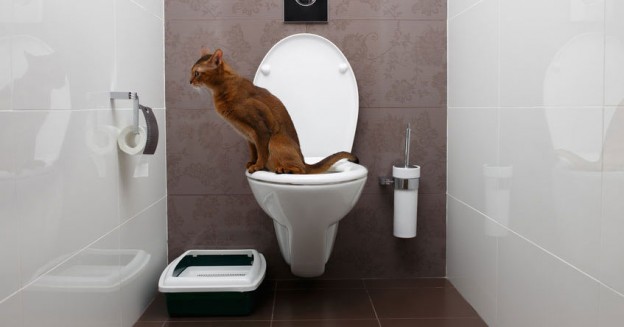Avoid Toilet Disasters: Don't Flush Cat Poop Down Your Toilet - Expert Guidance
Avoid Toilet Disasters: Don't Flush Cat Poop Down Your Toilet - Expert Guidance
Blog Article
What're your opinions regarding How to Dispose of Cat Poop and Litter Without Plastic Bags?

Intro
As pet cat owners, it's vital to bear in mind how we dispose of our feline close friends' waste. While it may appear practical to purge cat poop down the toilet, this method can have damaging effects for both the setting and human wellness.
Ecological Impact
Purging pet cat poop presents damaging microorganisms and parasites into the water system, presenting a substantial risk to water ecological communities. These contaminants can negatively influence marine life and concession water top quality.
Health and wellness Risks
In addition to environmental concerns, purging feline waste can likewise present health threats to humans. Feline feces might contain Toxoplasma gondii, a bloodsucker that can cause toxoplasmosis-- a potentially extreme disease, particularly for expectant women and individuals with weakened immune systems.
Alternatives to Flushing
Luckily, there are safer and a lot more accountable means to dispose of feline poop. Think about the adhering to alternatives:
1. Scoop and Dispose in Trash
One of the most typical technique of dealing with feline poop is to scoop it into an eco-friendly bag and toss it in the trash. Make sure to utilize a devoted clutter inside story and deal with the waste immediately.
2. Usage Biodegradable Litter
Opt for naturally degradable pet cat litter made from products such as corn or wheat. These clutters are environmentally friendly and can be securely disposed of in the garbage.
3. Bury in the Yard
If you have a yard, take into consideration burying pet cat waste in a designated location away from vegetable gardens and water resources. Be sure to dig deep adequate to avoid contamination of groundwater.
4. Set Up a Pet Waste Disposal System
Buy a pet garbage disposal system specifically developed for cat waste. These systems make use of enzymes to break down the waste, minimizing odor and environmental influence.
Verdict
Accountable pet dog ownership extends past providing food and shelter-- it likewise involves appropriate waste monitoring. By refraining from flushing feline poop down the toilet and opting for alternative disposal methods, we can minimize our ecological footprint and protect human health and wellness.
Why Can’t I Flush Cat Poop?
It Spreads a Parasite
Cats are frequently infected with a parasite called toxoplasma gondii. The parasite causes an infection called toxoplasmosis. It is usually harmless to cats. The parasite only uses cat poop as a host for its eggs. Otherwise, the cat’s immune system usually keeps the infection at low enough levels to maintain its own health. But it does not stop the develop of eggs. These eggs are tiny and surprisingly tough. They may survive for a year before they begin to grow. But that’s the problem.
Our wastewater system is not designed to deal with toxoplasmosis eggs. Instead, most eggs will flush from your toilet into sewers and wastewater management plants. After the sewage is treated for many other harmful things in it, it is typically released into local rivers, lakes, or oceans. Here, the toxoplasmosis eggs can find new hosts, including starfish, crabs, otters, and many other wildlife. For many, this is a significant risk to their health. Toxoplasmosis can also end up infecting water sources that are important for agriculture, which means our deer, pigs, and sheep can get infected too.
Is There Risk to Humans?
There can be a risk to human life from flushing cat poop down the toilet. If you do so, the parasites from your cat’s poop can end up in shellfish, game animals, or livestock. If this meat is then served raw or undercooked, the people who eat it can get sick.
In fact, according to the CDC, 40 million people in the United States are infected with toxoplasma gondii. They get it from exposure to infected seafood, or from some kind of cat poop contamination, like drinking from a stream that is contaminated or touching anything that has come into contact with cat poop. That includes just cleaning a cat litter box.
Most people who get infected with these parasites will not develop any symptoms. However, for pregnant women or for those with compromised immune systems, the parasite can cause severe health problems.
How to Handle Cat Poop
The best way to handle cat poop is actually to clean the box more often. The eggs that the parasite sheds will not become active until one to five days after the cat poops. That means that if you clean daily, you’re much less likely to come into direct contact with infectious eggs.
That said, always dispose of cat poop in the garbage and not down the toilet. Wash your hands before and after you clean the litter box, and bring the bag of poop right outside to your garbage bins.
https://trenchlesssolutionsusa.com/why-cant-i-flush-cat-poop/

I recently found that article on Don’t flush cat feces down the toilet when doing a search on the internet. Are you aware of anybody else who is curious about the niche? Please feel free to share it. Thank you for taking the time to read it.
Here Report this page